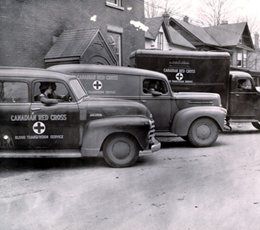Appeal launched to support people impacted by the earthquake in Myanmar
Read More

The outbreak of the Second World War in September 1939 returned the Canadian Red Cross Society (CRCS) to its roots as a wartime humanitarian aid organization, and returned it to the size and strength of 1918... and then some. Although the Society continued to engage in its various public health activities at home, for the duration of the war the Society’s primary focus was on providing aid to sick, wounded and captured troops. The Society’s wartime work also expanded in this war to include aid to civilian victims of the war (particularly bombed out British civilians during the Battle of Britain) and comforts for combatant troops, rather than simply the sick and wounded. These changes were mirrored in other British Commonwealth Red Cross societies, and in line with long-time American Red Cross practice. Canadians responded generously.
The CRCS’s work in WWII was much the same as its work in WWI: Canadians donated millions of dollars and countless hours of voluntary labour to fundraising efforts, the creation of comforts and supplementary medical supplies, and the packing of food parcels for Prisoners of War (all of which were then shipped overseas and distributed). Another overseas headquarters was established in London, England, where the same type of visits to convalescing servicemen, tracking of missing soldiers, sailors and airmen, and records of Prisoners of War were maintained. This time the Society focused its hospital-building efforts on one location: a bigger, better Taplow hospital on the Astor family’s Cliveden estate. One new development was the creation of the Canadian Red Cross Corps, a body of uniformed, trained, disciplined women volunteers ready for service in case of emergency; several hundred served with the Red Cross overseas in Britain or Europe, while others escorted war brides across the Atlantic after the war. Another development was the blood program: across Canada, the Red Cross collected civilian blood for use in the relatively new, life-saving procedure of blood transfusion, in military hospitals overseas. Canadians responded generously to this new opportunity to help save the lives of the sick and wounded.
Source:
CRCS. Annual Reports. 1939-1945.